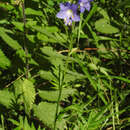Associations
provided by BioImages, the virtual fieldguide, UK
In Great Britain and/or Ireland:
Foodplant / feeds on
pycnidium of Phoma coelomycetous anamorph of Phoma polemonii feeds on Polemonium caeruleum
Foodplant / spot causer
amphigenous, loosely gregarious, immersed pycnidium of Phyllosticta coelomycetous anamorph of Phyllosticta polemonii causes spots on fading leaf of Polemonium caeruleum
Remarks: season: 7-8
Foodplant / parasite
telium of Puccinia polemonii parasitises live petiole of Polemonium caeruleum
Foodplant / feeds on
pycnidium of Septoria coelomycetous anamorph of Septoria polemonii feeds on Polemonium caeruleum
Comments
provided by eFloras
Jacob's Ladder is common in cool temperate and subalpine forests all over the northern region of W.Pakistan, 2500—4000 m. Prefers shady places with rich soil and sufficient humidity.
- license
- cc-by-nc-sa-3.0
- copyright
- Missouri Botanical Garden, 4344 Shaw Boulevard, St. Louis, MO, 63110 USA
Description
provided by eFloras
30 cm—1 m tall, slightly hairy or glabrescent. Stem leafy. Leaves 5—25 cm long; leaflets many, lanceolate, acuminate, sessile, 1—4 cm long, 3—8 mm broad. Calyx campanulate, 5—10 mm long, hairy. Corolla funnel-shaped, blue, occasionally white, c. 2 cm in diam., tube very short. Stamens included. Style protruded. Capsule c. 5 mm in diam.. ellipsoid. included in the calyx, dehiscing by 3 valves.
- license
- cc-by-nc-sa-3.0
- copyright
- Missouri Botanical Garden, 4344 Shaw Boulevard, St. Louis, MO, 63110 USA
Description
provided by eFloras
Stems erect, 30-100 cm, glabrous or sparsely glandular-pubescent above middle. Leaves pinnately compound, 7-14(-25) cm, gradually reduced upward, distal leaves ± sessile; petiole 1.5-8 cm; leaflets 11-27, ovate to lanceolate, 1-4 cm 2-14 mm, glabrous to sparsely pilose. Pedicel 3-5(-10) mm, puberulent to villous, trichomes often minutely glandular. Calyx 5-8 mm; lobes ca. as long as tube, oblong to lanceolate, apex obtuse to acuminate. Corolla violet to blue-violet, broadly campanulate, 1-2 cm; lobes obovate, margin glabrous to sparsely ciliate, apex rounded to ± acute. Stamens ca. as long as corolla, rarely shorter or longer than corolla. Style longer than stamens, slightly exserted. Capsule 5-7 mm. Seeds brown, 3-3.5 mm. Fl. Jun-Aug, fr. Jun-Sep. 2n = 14, 18 + 0-1B.
- license
- cc-by-nc-sa-3.0
- copyright
- Missouri Botanical Garden, 4344 Shaw Boulevard, St. Louis, MO, 63110 USA
Distribution
provided by eFloras
Distribution: Europe, N. and Central Asia, N. America.
- license
- cc-by-nc-sa-3.0
- copyright
- Missouri Botanical Garden, 4344 Shaw Boulevard, St. Louis, MO, 63110 USA
Distribution
provided by eFloras
Heilongjiang, Jilin, Liaoning, Nei Mongol, Xinjiang, NW Yunnan [India, Japan, Kashmir, Korea, Mongolia, Nepal, Pakistan, Russia; Europe, North America]
- license
- cc-by-nc-sa-3.0
- copyright
- Missouri Botanical Garden, 4344 Shaw Boulevard, St. Louis, MO, 63110 USA
Flower/Fruit
provided by eFloras
Fl. Per. July—August.
- license
- cc-by-nc-sa-3.0
- copyright
- Missouri Botanical Garden, 4344 Shaw Boulevard, St. Louis, MO, 63110 USA
Habitat
provided by eFloras
Streambanks or moist sites in meadows, open slopes, open sites in forests; (1000-)1700-3700 m.
- license
- cc-by-nc-sa-3.0
- copyright
- Missouri Botanical Garden, 4344 Shaw Boulevard, St. Louis, MO, 63110 USA
Polemonium caeruleum
provided by wikipedia EN
Polemonium caeruleum, known as Jacob's-ladder[2] or Greek valerian, is a hardy perennial flowering plant. The plant produces cup-shaped, blue or white flowers. It is native to temperate regions of Europe. It is the type species of the phlox family, Polemoniaceae.
Growth
The plant usually reaches 45–60 cm (18–24 in) tall and broad, but some occasionally grow taller than 90 cm (35 in). It can grow in North American hardiness zone 2.
Habitat
The plant is native to damp grasslands, woodlands, meadows and rocky areas in temperate areas of Europe and Asia.[3]
Cultivation
The plant normally prefers soil that is rich in moisture and lime with partial shade. Normally hardy, some cultivars (e.g. 'Blue Pearl') behave as tender biennials, which means they are effectively annuals in cooler climates (below hardiness zone 6).
The plant is known to have a few landscape uses as well such as attracting beneficial insects. The plant itself is convenient for container planting due to the shape of its growth. The flower may be presented as a cut flower or foliage and may be added to bouquets for its pleasant smell. It can be grown in a perennial border or rock garden.[4]
Cultivars include:
- 'Album' (white flowered)
- 'Blue Pearl'
- 'Brise d'Anjou'
- 'White Pearl' (white flowered)
- 'Snow and Sapphires' (variegated foliage)[5][6]
The plant does not have serious insect or disease problems. Leaf spot and powdery mildew can be problems, particularly in humid climates. The foliage may scorch if the plant gets too much sunlight. The leaflet tips will brown up if soils are allowed to dry out. The foliage will generally decline and become less attractive as the summer progresses. It is important to keep an eye out for slugs.[3]
References
- license
- cc-by-sa-3.0
- copyright
- Wikipedia authors and editors
Polemonium caeruleum: Brief Summary
provided by wikipedia EN
Polemonium caeruleum, known as Jacob's-ladder or Greek valerian, is a hardy perennial flowering plant. The plant produces cup-shaped, blue or white flowers. It is native to temperate regions of Europe. It is the type species of the phlox family, Polemoniaceae.
- license
- cc-by-sa-3.0
- copyright
- Wikipedia authors and editors

